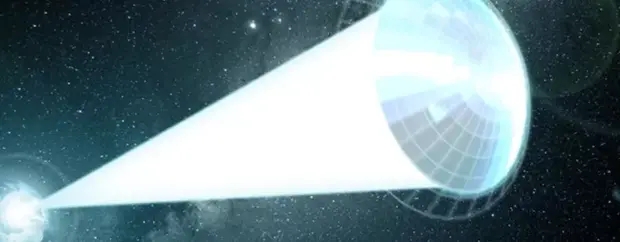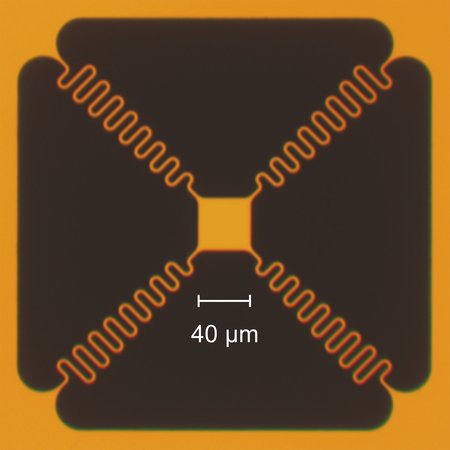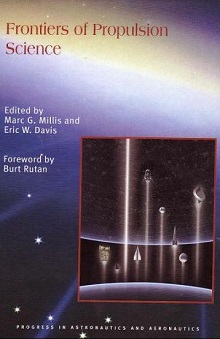Experimenting on beamed energy and sailcraft is no easy matter, as I hope the previous post made clear. Although useful laboratory experiments have been run, the challenges involved in testing for sail stability under a beam and sail deployment are hard to surmount in Earth’s gravity well. They’re also demanding in terms of equipment, for we need both the appropriate lasers and vacuum chambers that can approximate the conditions the sail will be subjected to in space. But this space is being explored now more than ever before. Jim Benford has pointed me to an excellent bibliography on lightsail studies at Caltech that I recommend to anyone interested in following this further.
When I said we were in the early days of sail experimentation, I was drawing your attention to the fact that we’re only now learning how to produce and manipulate the metamaterials – structures that have electromagnetic properties beyond those we find in naturally occurring materials – that may be our best choices for sail material. Here I’m looking at a paper I cited last time, by Jadon Lin (University of Sydney) and colleagues. Lin points out that we need to put any sail materials through a battery of tests. Let me quote the paper on this, as the authors sum it up better than I could:
To name a few, tests are needed for: more complete characterization of linear and nonlinear optical properties of candidate materials over the broad NIR-Doppler band and MIR band [Near-Infrared and Mid-Infrared] and over the full range of temperatures a sail may encounter; initially small scale, then large scale nanostructure fabrication followed by complete optical characterization of their scattering; structural tests and; direct radiation-pressure measurements. In particular, low defect, high purity synthesis and nanostructuring of materials over square meter scales will require substantial technological advancements, especially for the intricate designs found by inverse design that are often unintuitive.

Image: An artist’s conception of a lightsail during acceleration by a ground-based laser array. Here the sail appears curved, as many early studies had indicated. Now we’re learning that flat sails have a new life of their own. Read on. Image credit: Masumi Shibata/Breakthrough Initiatives.
Quiet Revolution
Let’s back out to the big picture for a moment, because materials science is moving so rapidly. We went from flat sails to rotating parabolic shapes in early sail analysis, hoping to find a way to keep a sail inundated with a 50 GW beam stable under acceleration. The revolution now emerging with metamaterials is that we are returning to the flat sail concept. Instead of a shaped reflective surface, we’re envisioning using properties of the sail material, including photonic metagratings. Unlike a curved, lens-like surface, these are ‘scatterers’ at the nano-scale that direct and shape incoming light. Recent research shows we can use these to produce restoring forces and torques that keep a flat sail stable. This in its own way is something of a revolution.
We need to evaluate candidate materials and the methods of fabrication that will produce them, and then factor all of this into the design of the actual sail membrane. It’s telling that, according to Lin’s paper, the flexibility of the membrane and its relation to sail stability is in need of extensive testing, and so is the question of special relativity and sail dynamics, which when we’re discussing interstellar sails and their velocities must be considered. Gratings and metastructures, the authors believe, are the best ways to cope with distorted sail shapes or the effects of relativistic velocities. To some extent we can test these matters on the interplanetary level with small sails in space.
Let’s now wind this back to the Breakthrough Starshot concept, announced in 2016 and pursued through sail studies in following years. Here the idea is to use a ground-based laser array to push tiny payloads attached to lightsails up to 20 percent of the speed of light, making the journey to the nearest stars a matter of two decades. The technology could be applied to various systems, but of course Alpha Centauri is the obvious first candidate, and in particular Proxima Centauri b a prime target in the habitable zone.

Harry Atwater, a professor of applied physics and materials science at Caltech, has been at the forefront of sail research, focusing on the ultrathin membranes that will have to be developed to make such journeys possible. He and his colleagues have developed a platform for studying sail membranes that can measure the force that lasers exert on such sails, an example of the movement from theory to laboratory observation and measurement. Atwater sees the matter this way:
“There are numerous challenges involved in developing a membrane that could ultimately be used as lightsail. It needs to withstand heat, hold its shape under pressure, and ride stably along the axis of a laser beam. But before we can begin building such a sail, we need to understand how the materials respond to radiation pressure from lasers. We wanted to know if we could determine the force being exerted on a membrane just by measuring its movements. It turns out we can.”
Image: Caltech’s Harry Atwater. Credit: California Institute of Technology.
The Sail as Trampoline
The team’s paper on these early measurements of radiation pressure on lightsail materials appears in Nature Photonics (citation below). To measure these forces, the team creates a lightsail in miniature, tethered at the corners within a larger membrane. Electron beam lithography is the means of crafting a silicon nitride membrane a scant 50 nanometers thick, producing the result seen in the image below. As of now, silicon nitride seems to have the inside track as the leading material candidate
The Caltech researchers note their experiment’s similarity to a tiny trampoline – the membrane is a square some 40 microns wide and 40 microns long, and as the Caltech materials show, it is suspended at the corners by silicon nitride springs. So we have a tiny lightsail tethered within a larger membrane as the subject of our tests.

Image: A microscope image of the Caltech team’s “miniature trampoline,” a tiny lightsail tethered at the corners for direct radiation pressure measurement. Credit: Harry Atwater/Caltech.
The method is to subject the membrane to argon laser light at a visible wavelength, measuring the radiation pressure that it experiences by its effects on the motion of the ‘trampoline’ as it moves up and down. The tethering of the sail is itself a challenge, with the sail acting as a mechanical resonator that vibrates as the light hits it. Crucial to the measurement is to subtract the heat from the laser beam from the actual direct effect of radiation pressure. Ingeniously, the researchers quantified the motion induced by these long-range optical forces, measuring both the force and power of the laser beam.
This is intriguing stuff. A lightsail in space is not going to stay perpendicular to a laser source beaming up from Earth, so the measurements have to angle the laser beam in various ways to approximate this effect. The tiny signal from the motion of the lightsail material is isolated through the use of a common-path interferometer that effectively screens out environmental noise. The interferometer was integrated into the microscope being used to measure the sail, with the whole apparatus contained within a vacuum chamber. The result: Measurements down to the level of picometers could be detected, and mechanical stiffness shown by the motion of the springs as the sail was pushed by the radiation pressure from the laser.

Image: This is Figure 1 from the paper. Caption: From interstellar lightsails to laboratory-based lightsail platforms. a, Concept of laser-propelled interstellar lightsail of 10 m2 in area and 100 nm or less in thickness. b, Laboratory-based lightsail platforms relying on edge-constrained silicon nitride membranes (left), linearly tethered membranes (middle) and spring-supported membranes (right). Removing the edge constraint allows to decouple the effects of optical force and membrane deformation, model lightsail dynamics, and study optical scattering from the edges. Suspending lightsails by compliant serpentine springs rather than linear tethers significantly increases its mechanical susceptibility to laser radiation pressure of the same power P, resulting in larger out-of-plane displacement Δz for more precise detection. Credit: Michaeli et al.
The crucial issue of stability takes in the spread of the laser beam at an angle, with some of the beam missing the sample, perhaps due to its hitting the edge of the sail, scattering some of the light. It will be imperative to control any sideways motion and rotation in the sail once it is under the beam through careful crafting of the metamaterials from which it is made. Co-author Ramon Gao, a Caltech graduate student in applied physics, summarizes it this way:
“The goal then would be to see if we can use these nanostructured surfaces to, for example, impart a restoring force or torque to a lightsail. If a lightsail were to move or rotate out of the laser beam, we would like it to move or rotate back on its own. [This work] is an important stepping stone toward observing optical forces and torques designed to let a freely accelerating lightsail ride the laser beam.”
Thus we take an early step into the complexities of sail interaction with a laser. The paper presents the significance of this step:
Our observation platform enables characterization of the mechanical, optical, and thermal properties of lightsail prototype devices, thus opening the door for further multiphysics studies of radiation pressure forces on macroscopic objects. Additionally, photonic, phononic [sound-like waves traveling through a solid] or thermal designs tailored to optimize different aspects of lightsailing can be incorporated and characterized. In particular, characterizing and shaping optical forces with nanophotonic structures for far-field mechanical manipulation is central to the emerging field of meta-optomechanics, allowing for arbitrary trajectory control of complex geometries and morphologies with light. Laser-driven lightsails require self-stabilizing forces and torques emerging from judiciously designed metasurfaces for beam-riding. We expect that their direct observation is possible using our testbed, which is an important stepping stone towards the realization of stable, beam-riding interstellar lightsails, and optomechanical manipulation of macroscopic metaobjects.
We are, in other words, doing things with light that are far beyond what the early researchers into lightsails would have known about. I think about Robert Forward and Freeman Dyson at the 1980 JPL meeting I referred to last time, working out the math on an interstellar lightsail. Imagine what they would have made of the opportunity to use metamaterials and nanostructures to craft the optimum beam-rider. It’s heartening to see how the current effort at JPL under Harry Atwater is progressing. Laboratory experimentation on lightsails builds the knowledge base that will ultimately help us craft fast sails for missions within the Solar System and one day to another star.
The Atwater paper on sail technologies is Michaeli et al., “Direct radiation pressure measurements for lightsail membranes,” Nature Photonics 30 April 2025 (abstract). Also referred to above is Lin et al., “Photonic Lightsails: Fast and Stable Propulsion for Interstellar Travel,” available as a preprint.



Was wondering what became of the cone-shaped sail. Would seem to answer the need for stability and self-correction geometrically. Can the principles of meta-materials with defraction grating be applied to a conical surface? Is it because a planar sail less susceptible to a collapse from light pressure than a cone? When referring to the grating applying torque, is this a means to control the spin of the sail in its plane, or is it more of a pitch/yaw control?
In the video”Starshot From Science to Spacecraft and Missions” starting at 12:45 to 14:52 minutes, he discusses the issues with conical light sails.
https://www.youtube.com/watch?v=jV2sNOYzaFA
Watched the video, did see some results showing stability for a parabolic sail with the wide end facing the beam.
However I always interpreted a ‘cone-shaped’ sail to be an actual pointy cone, with the pointy end pointing to the oncoming beam. Not sure my interpretation was correct, but it seemed intuitively obvious that what is essentially a dreidel shape would be ‘self-righting’ and would tend to steer itself back into the vertical w/respect to the beam if it were perturbed.
An ultra thin dreidel sail, though, would collapse like an inverted umbrella in the wind. Hence my wondering if a grating in the cone’s surface could applying a restoring force or spin the cone sufficiently about its access to prevent it from collapsing? Maybe a solid cone, made of ultra-light aerogel? A cloud of micro-cone sails?
The Arxiv version of the Nature Photonics paper can be found here.
It’s good to see that the concept is moving to detailed laboratory observation and measurement. I like seeing the detailed resolution of the forces and responses of that tiny lightsail!
To answer Project Studio, the cone-shaped sail, which I used to study beam-riding experimentally back about 23 years ago, did produce stable operation under a microwave beam. There was a restoring force because of the shape. I expected it to do so, and it did. But metamaterials and diffraction gratings are harder to apply to a conical surface. Perhaps more complex structures of such materials can get the advantages of both the conical shape and the scattering forces.
I suspect these self-correcting behaviors don’t scale. In a large structure the resulting propagating waves (compression, expansion, etc.) will be quite complex and won’t damp in concert with the desired net displacements of the whole structure. It may help to (slowly) rotate the sail even if it seems to add unwanted complication to their far smaller prototypes.
https://phys.org/news/2025-03-scalable-nanotechnology-based-lightsails-generation.html
March 24, 2025
Scalable nanotechnology-based lightsails developed for next-generation space exploration
by Delft University of Technology
Researchers at TU Delft and Brown University have developed scalable nanotechnology-based lightsails that could support future advances in space exploration and experimental physics.
Their research, published in Nature Communications, introduces new materials and production methods to create the thinnest large-scale reflectors ever made.
https://www.nature.com/articles/s41467-025-57749-y
Here is a very important aspect of developing an interstellar probe: Can it be affordable:
https://www.optica-opn.org/home/newsroom/2025/march/interstellar_sailing_might_not_break_the_bank/
I guess we will worry after about who is going to build, maintain, control, and protect a megalaser so it is not turned into a weapon. Of course how these things usually work is, a device comes into existence first because it desired as a military weapon, then the civilian (business) aspects come after. The rocket is a prime example here.
https://www.msn.com/en-us/news/world/us-allies-in-the-middle-east-are-racing-to-get-new-laser-defense-weapons/ar-AA1BBOmG?ocid=BingNewsVerp
https://www.msn.com/en-us/news/other/russia-develops-anti-drone-laser-gun/ar-AA1C4Jlh?ocid=BingNewsVerp
https://wonderfulengineering.com/lockheed-martin-wins-150m-us-navy-laser-weapon-contract/